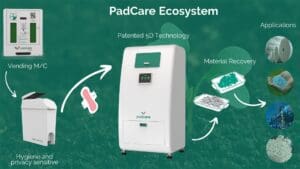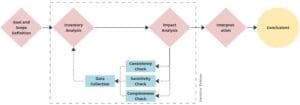System LCA
Conducting LCAs to quantify environmental impacts, avoided emissions and carbon storage for systems.

System LCA offers a holistic view, meticulously examining every facet of a system’s life cycle, from inception to disposal. This inclusive approach considers the primary product and associated processes, services, and interactions. Doing so provides a comprehensive understanding of the environmental footprints associated with the entire system.
The following points illustrate the significance of conducting Life Cycle Assessments (LCAs) across various domains to understand and mitigate environmental impacts. Each example demonstrates how LCAs provide insights into the environmental footprint of complex systems.
- A system LCA can be conducted for a comprehensive menstrual pad disposal and recycling system. It would quantify the environmental impacts across the collection, transportation, and recycling of used pads. The assessment would also quantify emission reductions by avoiding landfilling or incineration. Such a system LCA maps the various stages involved, providing insights into hotspots and opportunities for improvement across the product life cycle.
- Conducting a comprehensive LCA for online food delivery operations can help organisations gain many insights. Defining an expansive system boundary encompassing all interconnected components – sourcing, manufacturing, warehousing, transportation, e-commerce platforms, packaging, and waste management – provides an integrated perspective. This holistic view can lead to decarbonisation across the entire delivery system lifecycle.
- A system-wide LCA approach can comprehensively quantify the environmental impacts of a large office campus comprising multiple interconnected components. The system boundary can encompass buildings, transportation systems between facilities, centralised utilities, water supply, sewage treatment infrastructure, and waste management operations. By taking this integrated perspective, aspects such as the embodied carbon emissions associated with building construction materials can be evaluated alongside the environmental benefits of on-site water treatment processes. A system LCA provides a holistic view with optimisation opportunities across the campus.
Furthermore, in system LCAs, one environmental impact indicator can be prioritised over others based on the specific details and characteristics of the system being evaluated. For example, in assessing the life cycle impacts of a transportation system, greenhouse gas emissions and air pollution may be given higher priority compared to other indicators like water consumption or land use. This is because the primary environmental concerns associated with transportation systems are typically related to their contribution to climate change and air quality issues. On the other hand, water consumption and effluent quality may be the most critical impact indicators to focus on for a water treatment system, taking precedence over others like energy use or material consumption. By prioritising relevant impact categories, system LCAs can provide targeted insights and recommendations tailored to the unique attributes and challenges of the system under study.
Life Cycle Assessment (LCA) for systems is a crucial service, and Monk Spaces assists companies in quantifying their sustainable initiatives. By leveraging insights from reputable sources and drawing on established methodologies such as ISO 14040 and 14044, the accuracy and relevance of assessments are ensured.




